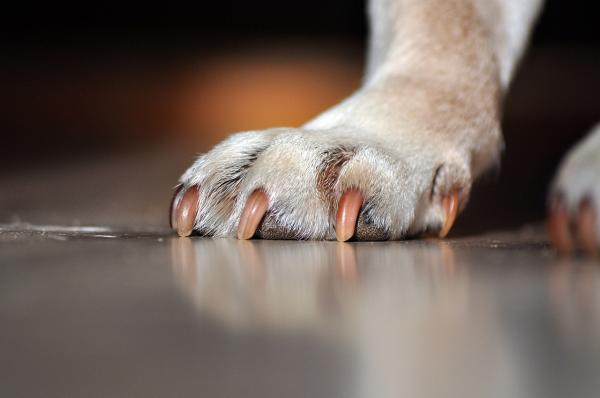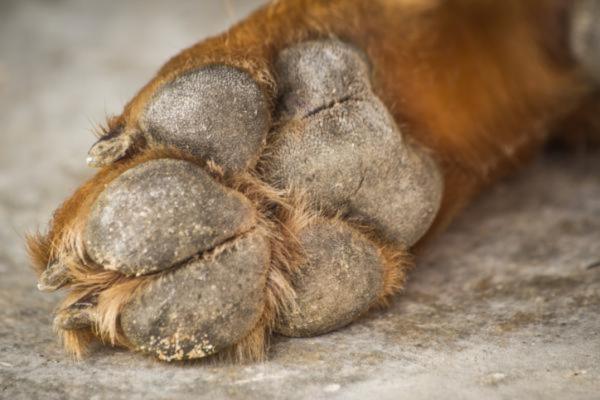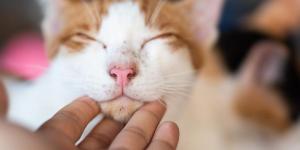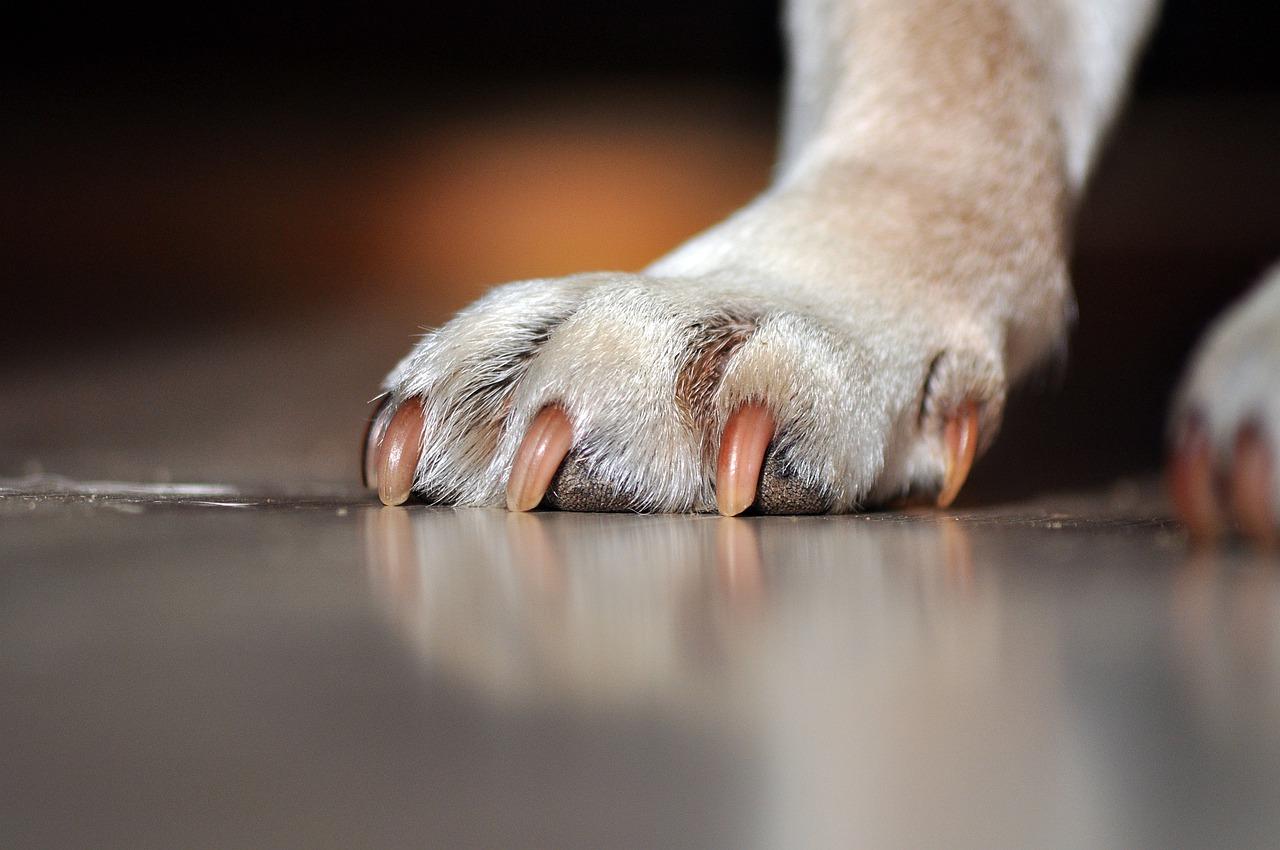Dog Paw Problems - Causes, Symptoms and Treatment



See files for Dogs
It is difficult to overstate the importance of proper footcare in our dogs. The skin on the plantar area of the paw pads is both resistant and sensitive. As dogs move, their paws come in contact with the ground which can be of various textures and materials. The paw pad itself is made up of fatty tissue covered in a thick layer of skin which is itself covered in a layer of keratinized skin. This hardened skin helps to protect the paws from ground contact, while the fatty tissue acts as cushioning. While nature has designed the dog's paws to function incredibly well, they are still vulnerable to disease and other problems.
At AnimalWised, we look at the most common conditions affecting a dog's feet with our list of 7 dog paw problems. We look at the causes, symptoms and treatment of these various problems and see what you and do to prevent them happening in the first place.
Dog paw trauma
As the dog's paws are almost continuously coming in contact with various surfaces, the risk of physical trauma is ever present. While we can better manage the indoor environment of our home, we cannot do the same for public spaces and other outdoor environments. When walking our dog, we need to be particularly careful of the following potential injuries:
- Burns: both by physical and chemical agents. In summer, the ground temperature can become very high. This is especially so in countries with warm climates. Asphalt, tarmac and other types of surfaces can become so hot they burn our dog's paws. When the ground is freezing during winter, this can also cause burns to the dog's paws. Chemical agents and corrosive substances spilled on the ground can also cause skin burns.
- Cuts and wounds: it is depressingly common to find various sharp objects which can cut our dog's paws when they walk outdoors. Urban environments are usually the most likely to provide dangers such as broken glass, needles, sharp wires and many other materials which can cause lacerations. Since they are often in unhygienic areas, these cuts are also at risk of secondary infection.
- Abrasions and ulcers: walking on very abrasive floors, such as asphalt, cement or even sand at the beach can cause abrasions to develop on the dog's paws. As with lacerations, these dog paw problems can also become infected and ulcerate.
Learn more about the structure of a dog's paws with our article on dog paw pad anatomy.
Plantar hyperkeratosis
The next of our dog paw problems is related to the keratinized tissue of the paw pads. Hyperkeratosis is a process which results in the thickening and hardening of this tissue caused by excess keratin. We will also see the dog's paw pads become dry and cracked. This can occur on other areas of the body, but when it is a dog paw pad problem, it is known as plantar hyperkeratosis.
Plantar hyperkeratosis in dogs can appear for several reasons, the most frequent being:
- Infectious/parasitic diseases: such as leishmaniasis or canine distemper.
- Hereditary diseases: such as familial hyperkeratosis of the plantar pads.
- Autoimmune diseases: such as pemphigus foliaceus in dogs.
- Diet deficiency: commonly due to zinc deficiency.
- Hepatocutaneous syndrome: degeneration of skin cells due to liver dysfunction.
In any of these cases, it is common for hyperkeratosis to also appear on the truffle area of the dog's nose.

Contact dermatitis
Contact dermatitis in dogs is an allergic reaction that occurs when the skin comes in contact with an allergen to which the animal is sensitive. When the contact dermatitis occurs on the dog's paw pads, it is usually triggered by one of the following:
- Chemicals: such as cleaning products, varnishes, etc.
- Environmental allergens: such as grass, soil or other natural materials.
After contact with the material that triggers the hypersensitivity reaction, a reddening of the paw pads and the interdigital area occurs. This can can evolve into the formation of erosive and hemorrhagic lesions.
Learn more about different types of skin inflammation with our article on atopic dermatitis in dogs.

Cutaneous vasculitis
The term vasculitis refers to an inflammatory process of the blood vessels. Although it can be a primary pathology, it generally occurs secondary to other medical conditions such as:
- Infections
- Neoplasms
- Adverse reactions to drugs
Cutaneous vasculitis in dogs refers to those which affect the skin, something which can include the plantar pads of their paws. They usually result in ulceration of the paws. The presence of a focal ulcerative lesion in the center of the pad is highly indicative of vasculitis, although there are other reasons for ulcers on a dog's skin.
Foxtails
The presence of foxtails coincides with the arrival of spring. A type of diaspore, foxtails are arrow-shaped seed pods which have sharp spikelets around their edge known as awns. The purpose of these spikes is to catch onto the coat of passing animals so they can be dispersed in other areas. Unfortunately, they are very sharp and they can cause traumatic injury to the skin, including those of the paw pads. It is one of the most common reasons dogs go to the vet in spring.
The spikes are capable of penetrating the skin on the pads. The spikes can cause ulcers and infections that drain to the outside forming fistulas. Learn more about the treatment and prevention of this dog paw problem with our guide to foxtails in dogs.
Plantar vitiligo
Vitiligo in dogs is a genetic disease in which there is a defect in melanocyte production or melanin synthesis. The result is a lack of skin pigmentation in certain areas, including the paw pads. This symptom is merely aesthetic, since its appearance does not affect the animal's welfare or quality of life.
It is worth mentioning that vitiligo is a disorder that can affect different parts of the body. Specifically, when it affects the plantar pads, it is called plantar vitiligo.
Uveodermatologic syndrome
Uveodermatological syndrome is an immune-mediated disease that causes ophthalmological and cutaneous alterations. Specifically, it is an autoimmune disease in which the immune system attacks the body's own melanocytes (cells responsible for melanin synthesis).
At the dermatological level, it causes depigmentation and skin erosion in different regions of the dog's body. This can include the paw pads. Unlike vitiligo, this syndrome can cause pain and other symptoms which require treatment or symptom management.

How to prevent dog paw problems
Although the pads are very resistant structures, they are subjected to continued abrasion due to friction against the ground surface. It is vital we pay attention to the following aspects of dog care to avoid dog paw problems:
- Avoid very hot or very cold ground: as we have seen, excessively hot or cold ground can cause significant burns on the dog's paw pads. For this reason, we should only take the dog outside for walks during the cooler hours of the day or after the sun has gone down. In winter or cold climates, we can protect the dog's paws with the use of special snowshoes for dogs. Other types of canine footwear can also be used to protect the dog's feet from excessively hot or cold ground.
- Walk in safe places: during walks, it is important to pay attention to the possible presence of sharp or pointed elements (such as glass, wires, nails, etc.). Avoid areas where these types of objects are frequently found and opt for safer walking areas.
- Avoid very abrasive terrain: to keep the dog's pads healthy, walks should preferably be carried out on soft soils, grass or lawn. As far as possible, abrasive surfaces such as asphalt, tarmac or stony terrain should be avoided.
- Keep the paw pads dry: when the dog's paw pads are submerged in water for too long, they become soft and can be more easily eroded by rubbing against the ground. It is important to dry the pads after walks in wet weather or if they have been in bodies of water. Similarly, when we bathe or groom our dog, we should reduce the amount of time they are submerged as much as possible and dry their paws immediately.
- Avoid areas with foxtails: with the arrival of good weather, it is advisable to avoid areas with cereal plantations to avoid problems associated with foxtails.
With these considerations in mind, you shouldn't need to add any topical ointments to keep their paw pads healthy. As with humans, there are some dogs which may be prone to dry skin. When this leads to dry and cracked skin on the paw pads, there are certain lotions which can be used to maintain their integrity. Speak to your veterinarian about how to moisturize your dog's skin and what products are best for them.
Whenever you detect any of the symptoms described throughout this article, do not hesitate to go to your veterinary clinic as soon as possible. They are best able to diagnose the problem and start suitable treatment. You may be able to provide some first aid, as you can see with our article on treating dog paw pad injuries.
This article is purely informative. AnimalWised does not have the authority to prescribe any veterinary treatment or create a diagnosis. We invite you to take your pet to the veterinarian if they are suffering from any condition or pain.
If you want to read similar articles to Dog Paw Problems - Causes, Symptoms and Treatment, we recommend you visit our Skin problems category.
- Association of Spanish Veterinarians Specialists in Small Animals. (2013). Dermatological problems.
- Lee, T., Ihrke, P., Walder, E., & Affolter, V. (2008). Skin diseases of the dog and cat. Clinical and histopathologic diagnosis. Blackwell.







